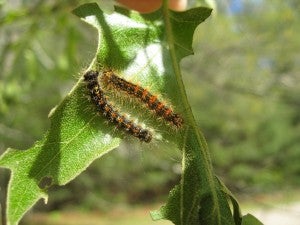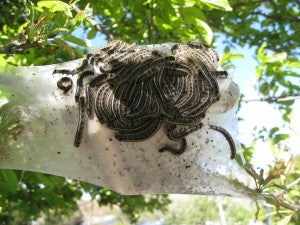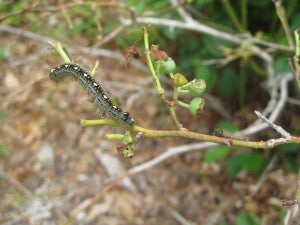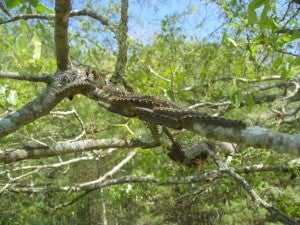Caterpillars!
Winter moth caterpillars were not as bad as expected – though some locations had large populations and blueberry and apple trees suffered a lot of damage. I do not know the status of the parasitic fly, Cyzenis albicans. I collected winter moth caterpillars at all 7 RI sites where the fly was released in previous years to check for parasitism. Results about parasitism will not be available for several months.
Gypsy moth caterpillars are about mid-size right now and just becoming obvious to many people. I’ve heard reports in North Smithfield and Cape Cod about gypsy moth caterpillars covering houses. It was pretty dry in May, but I’m hoping we’ve had enough wet weather to allow the 2 diseases to spread and start killing gypsy moth caterpillars soon. The diseases don’t start spreading until caterpillars are at the 3rd instar stage, which is what I think most gypsy moth caterpillars are right now. I haven’t seen any dead gypsy moths yet.




Gypsy moths will be feeding for another few weeks and are starting to damage trees. I think gypsy moth caterpillars are still small enough to be controlled by a Bt insecticide (such as Dipel), but I’m not sure. Bt insecticides work best controlling small caterpillars. Other insecticides labeled for gypsy moth will also be effective, but of course there are other risks using pesticides.
Soon gypsy moth caterpillars will be climbing up and down tree trunks daily. They will feed in trees at night and walk down trunks to be in shade during the day. For this reason, sticky tree bands or burlap wrapped around a tree trunk can catch gypsy moth caterpillars. If you put burlap around a tree, you need to check under the burlap each day and remove caterpillars and kill them. And if you use a sticky band, you will probably need to remove stuck caterpillars daily.
For tree fruit growers:
According to Orchard Radar, Plum Curculio will finish migrating into orchards by June 5 in the Greenville area and June 11th in Newport County. Pesticide applications made 7 days or fewer from these dates should provide adequate coverage to control plum curculio. If you are worried that rain on Monday washed off too much insecticide, scout fruit on trees near woods or stone walls for fresh plum curculio scars. If you don’t find fresh damage you shouldn’t need to spray.
Apple scab primary season is over. I haven’t seen ANY scab lesions this year, but I haven’t looked very much either. Jon Clements from UMass did report finding scab lesions. Over the next week look thoroughly for scab lesions, and for fire blight strikes. Let me know if you find some of either.
 Home
Home Browse
Browse Close
Close Events
Events Maps
Maps Email
Email Brightspace
Brightspace eCampus
eCampus


